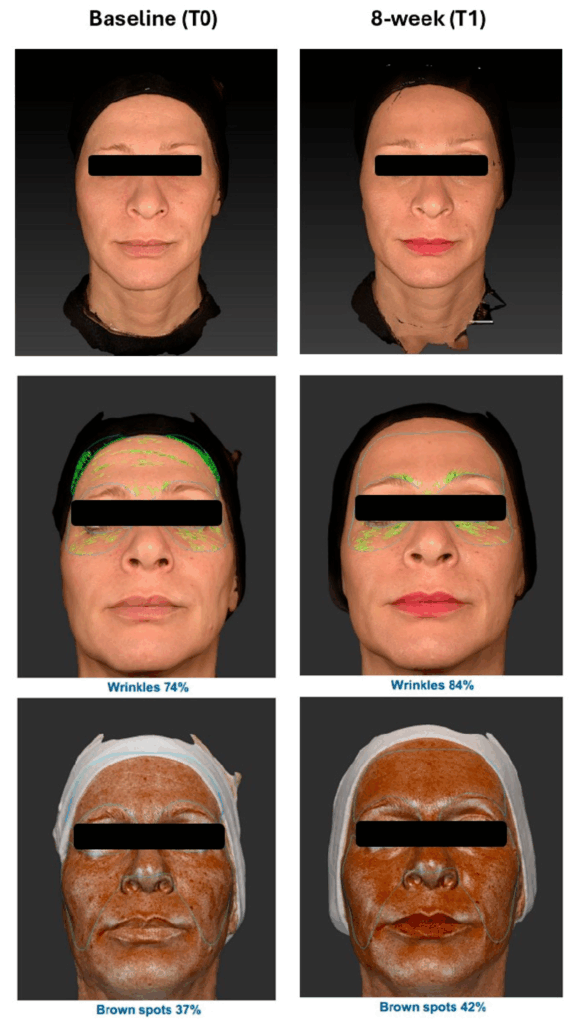Skin aging is a complex biological process influenced by a combination of intrinsic (genetic factors, hormonal fluctuations, cellular senescence) and extrinsic factors (UV radiation, pollution, smoking, diet). These factors lead to visible changes such as wrinkles, loss of elasticity, uneven skin tone, and hyperpigmentation. At a molecular level, skin aging involves oxidative stress, cellular senescence, degradation of the extracellular matrix (ECM), and mitochondrial dysfunction, all of which impair tissue repair and lead to structural deterioration.
To counteract these signs, hyaluronic acid (HA) is a widely recognized ingredient in cosmetic formulations due to its crucial role in maintaining skin moisture, firmness, and elasticity. As the body ages, HA levels decrease, leading to drier, less elastic skin and the formation of fine lines and wrinkles. Topical HA supplementation helps mitigate chrono- and photoaging effects by protecting skin from UV-induced damage, reducing reactive oxygen species (ROS) and inflammation, and supporting ECM structure.
Vitamin C (Ascorbic acid) has also gained significant relevance in cosmetics for its protective role against oxidative damage and its ability to boost collagen production. Furthermore, Vitamin C is well-established for its skin brightening and depigmenting effects. It achieves this by interfering with the activity of tyrosinase, an enzyme essential for melanin production, thereby reducing the formation of new pigments and helping to fade existing dark spots by reducing melanin oxidation and supporting skin cell turnover.
Given the individual benefits of HA and Vitamin C, this study aimed to investigate and directly compare the anti-aging efficacy of two topical formulations containing a high-concentration hyaluronic acid delivered in Opuntia oil (Jalubalance® technology): one with HA alone and another enriched with 1% Vitamin C. The rationale was to evaluate if the addition of Vitamin C, with its antioxidant, depigmenting, and collagen-stimulating properties, could provide enhanced anti-aging benefits over HA alone.
Methods
This was an 8-week, prospective, multicenter, randomized, parallel-group study involving 91 women aged 30–50 years with mild-to-moderate photoaging. Participants were randomized to apply either an HA-only cream (Group A) or an HA + Vitamin C cream (Group B) twice daily on cleansed skin. The primary outcome assessed was the percentage of subjects achieving at least a one-point improvement in hyperpigmentation score. Additional evaluations included clinical and instrumental assessments of wrinkles, elasticity, hydration, and participant satisfaction.
For objective instrumental evaluation, a Digital Skin Moisture Meter was used to measure skin hydration, sebum content, and skin elasticity. Additionally, a VISIA® objective face sculptor analysis was performed in a subgroup of 10 subjects. VISIA® evaluates different skin parameters, such as wrinkles and brown spots, using standardized and cross-polarized lighting, with results expressed as percentile scores where higher scores indicate an improvement in skin condition.
Key Findings
• Both the HA-only cream and the HA + Vitamin C cream significantly improved various signs of skin aging, including Glogau scores, wrinkle reduction, skin elasticity, and skin tone uniformity.
• Instrumental analysis confirmed that both treatments significantly increased skin hydration and elasticity.
• The HA + Vitamin C cream (Group B) resulted in a significantly greater reduction in hyperpigmentation (−45%) compared to the HA-only cream (Group A, −31%, p < 0.05).
• At week 8, 56% of subjects in Group B achieved a ≥1-point reduction in hyperpigmentation score, compared to 30% in Group A, demonstrating a clear added benefit of Vitamin C for pigmentation concerns (absolute difference: 26%; 95% CI: 5–43%; p < 0.05).
• VISIA® results in a subgroup confirmed visible improvement in parameters like wrinkles and brown spots in the HA + Vitamin C group, with the reduction in brown spots specifically attributed to Vitamin C’s brightening and depigmenting action.
• Participant satisfaction was high for both products across all evaluated parameters, with 100% of participants in both groups reporting excellent or good moisturization effects. Brightening effects were also well perceived in both groups.
• Correlation data indicated that improvements in Glogau score were strongly and independently associated with changes in hydration and sebum levels, suggesting these physiological parameters mediate clinical benefits.
This study confirms the moisturizing effectiveness of Jalubalance® technology and the clinical efficacy of both HA-only and HA + Vitamin C creams in reducing visible signs of skin aging, such as wrinkles, hyperpigmentation, and loss of firmness and elasticity, in individuals with mild-to-moderate photoaging.
The novelty of this research lies in its direct comparison of a hyaluronic acid formulation with and without Vitamin C, specifically utilizing the Jalubalance® technology (HA delivered in Opuntia oil). The findings distinctly highlight that while both formulations are effective anti-aging treatments, the inclusion of Vitamin C provides enhanced benefits, particularly in reducing hyperpigmentation. The study also offers an interesting insight that the clinical benefits of the HA + Vitamin C formulation may be largely mediated through its effects on skin hydration and sebum regulation rather than a direct standalone effect of the active combination, suggesting the importance of an optimized hydrolipidic balance for visual improvements. The use of objective tools like VISIA® further strengthens these findings by providing measurable data on improvements in specific skin parameters.
These results support the future implication of personalized dermatological approaches, allowing healthcare professionals to select the most appropriate formulation based on a patient’s specific clinical characteristics and pattern of skin aging, especially for those with significant pigmentation concerns.

VISIA® results of different skin parameters (wrinkles, brown spots) evaluated on baseline (T0) and after 8 weeks (T1) in a subject of Group B (HA + Vitamin C cream).
Link to the study: https://www.mdpi.com/2079-9284/12/4/177

